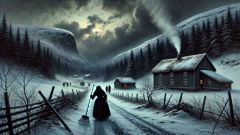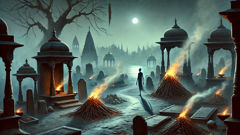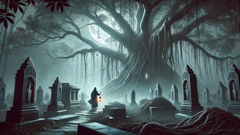Introduction
Long before the whisper of modern medicine touched the Scandinavian wilds, Norway’s fjords and forests were shrouded in both beauty and dread. The 14th century swept in on biting winds, carrying news of a pestilence that would soon become legend—the Black Death. Yet in Norway, as tales passed from fire to fire, the plague took on a face and a name: Pesta. Her presence was as chilling as a winter gale, her shadow falling across timbered farmhouses and mossy stone bridges. According to generations of villagers, Pesta was not merely a rumor or an imagined wraith; she was the walking embodiment of death itself, appearing as a hunched old woman wrapped in tattered black, eyes sunken like the dark crevices between the mountains. Her footsteps crunched through snow and mud alike, slow but unyielding. And wherever she went, she carried two simple tools—one a rake, the other a broom. These were no ordinary household implements. The rake, with its gnarled wooden tines, symbolized a faint hope: if she entered a home with it, some souls would survive, slipping through the cracks as hay through the rake’s teeth. But if she came wielding her broom, all within would be swept away—no one would be spared. The dread of Pesta’s arrival threaded itself into daily life, transforming the rhythm of rural existence. People watched for her with a mix of terror and fatalistic awe, reading omens in the curling mist and the hollow call of ravens. Children hushed their games at dusk, mothers locked doors and lit candles, and elders muttered prayers as twilight deepened. Villages that once rang with laughter and the clang of blacksmiths grew silent, save for rumors of farms left empty overnight. In this world, hope and despair danced in a fragile balance, and the legend of the Pesta was both warning and explanation—a way to name the unspeakable and give shape to the unknowable darkness sweeping the land.
Whispers in the Valley
It began with a rumor—soft as snow falling on moss, but sharp as ice in the marrow. The fjord-side village of Vikedal had always been a place of resilience, where people fished silver herring from the deep and tended goats on impossibly steep slopes. They sang songs that echoed across icy waters and passed stories from mother to child, shaping their world with memory. But in the spring of 1349, news arrived with traders and monks: the Black Death had come to Bergen, sweeping like wildfire along the coast, emptying houses and choking the churches with sorrow. Fear seeped into every conversation. Folk gathered beneath the eaves of the stave church, eyes darting toward the river, half-expecting the grim tide to crest the hills and flood their valley. It was then, as if summoned by collective dread, that Pesta first appeared.
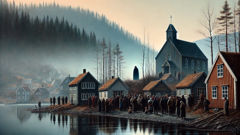
She was spotted at dawn by Sigrid, a widow who lived alone at the edge of the forest. Sigrid had risen early to tend her meager patch of cabbages, but instead of dew on the leaves, she found footprints—small, yet deep, leading away from her door into the thick pines. That same day, a fisherman named Einar saw a figure in black limping along the rocky shore. Her face was as pale as the moon, eyes black and endless. She paused, turned, and raised her broom as if in warning. Word spread as fast as the disease itself. Men spoke in hushed voices, describing her as neither living nor dead. Some claimed she had the stench of the grave; others swore she left no shadow in daylight. Children mimicked her gait in fearful play until their mothers scolded them into silence. At night, smoke from every hearth thickened with prayers and the acrid scent of burning juniper—an old ward against evil.
The legend quickly took root: if Pesta approached a house with her rake, at least one soul inside might survive. If she brought her broom, all would perish. A few brave villagers watched for her signs—unexplained cold, a sudden hush among animals, windows frosting over even in sunlight. The valley seemed to tighten around itself, bracing for a storm more ruthless than any winter.
The Night of the Rake
As days shortened and the sky grew ever more leaden, Vikedal’s villagers moved about their chores with the weight of fate pressing upon their shoulders. One by one, neighboring farms fell silent. Horses whinnied at nothing, and dogs cowered beneath beds. The only certainty was uncertainty itself—until the night Pesta came to the farm of Lars Gudmundsson.
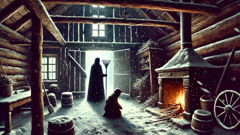
Lars was no stranger to misfortune. He’d lost two sons to the sea, and his wife had succumbed to fever years before. Yet he remained a pillar in the village, known for his stubbornness and the warmth he offered travelers. That winter night, a storm raged outside, rattling shutters and hurling sleet against the sod roof. Inside, Lars and his daughter Ingrid sat by the hearth, clutching hands as embers waned. A knock sounded at the door, impossibly gentle against the fury outside.
With heart pounding, Lars opened the door to find Pesta standing in the swirling snow. Her eyes were rimmed with red, her lips drawn in a crooked smile. But in her gnarled hands, she held the rake. Wordlessly, she entered, trailing the cold behind her. Lars fell to his knees, crossing himself; Ingrid hid her face in her shawl.
Pesta circled the room, her gaze falling on each family member in turn. When she stopped before Lars, she placed the rake gently at his feet, then vanished like a wisp of smoke. The silence that followed was absolute—no wind, no crackling fire, just the echo of her absence.
Days later, the Gudmundsson farm was struck by plague. Lars fell ill first, wracked by fever and black boils. Ingrid nursed him with what meager remedies she knew: broth spiced with angelica root, prayers whispered over his sleeping form. Still, death lingered at the threshold. Miraculously, when the sickness passed, Ingrid survived—pale and changed, but alive. The villagers whispered that Pesta’s rake had spared her, letting one life slip through while sweeping away another.
When the Broom Sweeps Clean
The mercy shown to Ingrid was rare. More often, Pesta appeared with her broom—her most dreaded omen. Word spread that she had crossed the river into Lilldal, a village nestled in a hollow between pine forests and stony crags. The villagers, gripped by terror, barricaded themselves indoors and burned tar over their thresholds. Yet none could prevent her arrival.
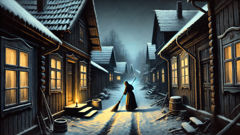
On the darkest night of midwinter, Lilldal was cloaked in silence, save for the howl of the wind and the distant baying of wolves. Astrid Knutsdatter, the healer, lay awake listening for trouble. She knew the signs: sudden chills that swept through rooms, the extinguishing of candles for no reason, the uneasy sleep that settled over livestock. She had heard tales of Pesta since childhood but never thought to meet her face to face.
When Astrid heard a faint scratching at her door, she shuddered. She rose, wrapped herself in a heavy woolen cloak, and lit a lantern. The moment she opened the door, she saw her: Pesta, gaunt and silent, holding a straw broom whose bristles swept patterns into the snow. Pesta’s gaze was bottomless, her presence like the cold itself. Without a word, she brushed the broom across Astrid’s threshold and turned away.
The next morning, Lilldal was still. Every house bore signs of death—windows left open to the frost in desperate hope, meals half-eaten on tables, fires gone cold. Not a single soul survived the night. It was as if Pesta’s broom had swept away every remnant of life, leaving only silence and memories drifting like snowflakes.
In time, the story of Lilldal became a warning sung by minstrels and repeated by mothers to their children: beware the old woman with the broom, for where she goes, none remain. But some whispered that Astrid’s spirit lingered in the woods, forever searching for answers to suffering that had no explanation.
Conclusion
As the years passed and the memory of plague faded, the legend of Pesta remained woven into Norway’s cultural fabric. Though the Black Death itself receded, her story echoed from mountain to fjord, a chilling reminder of a time when fate seemed to walk the earth in human shape. Some said Pesta was merely a tale spun to explain loss and terror; others believed she was a real presence, her passage immortalized in the hush of snowy evenings and the flicker of lanterns at dusk. Even now, in the quietest corners of rural Norway, elders tell children not to mock death or take health for granted—because Pesta walks where she wills, her broom ready to sweep away the careless and her rake sparing only the lucky few. The story endures not only as a warning but as a testament to resilience: faced with unimaginable loss, the people of Norway found strength in their stories, hope in their rituals, and community in their collective remembrance. The legend of Pesta stands as a shadow on the snowy landscape—grim, yet oddly comforting, for it gives name and form to forces beyond human control, binding generations together through the long, dark winters and the slow return of light.

